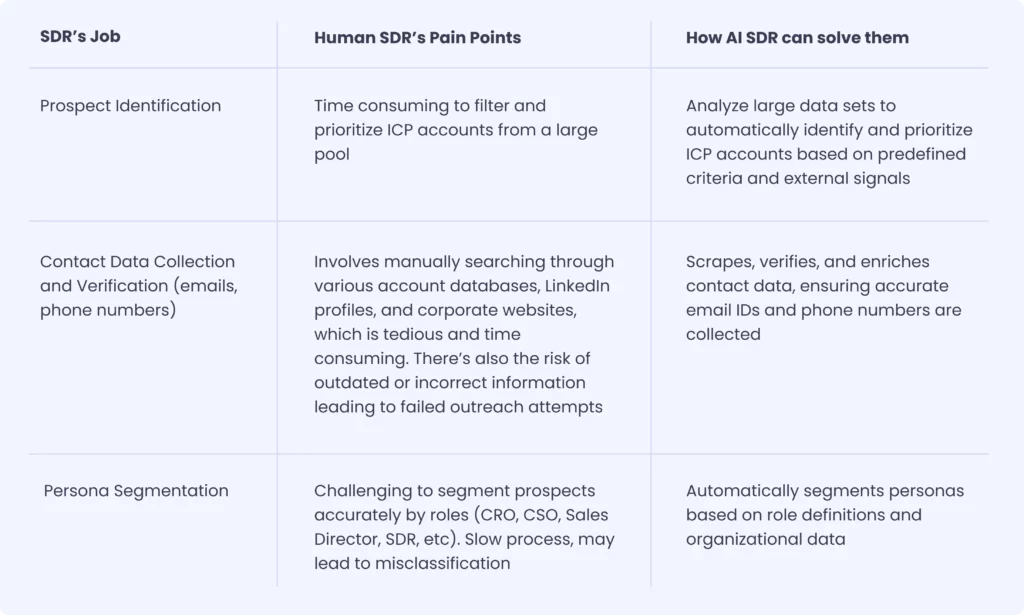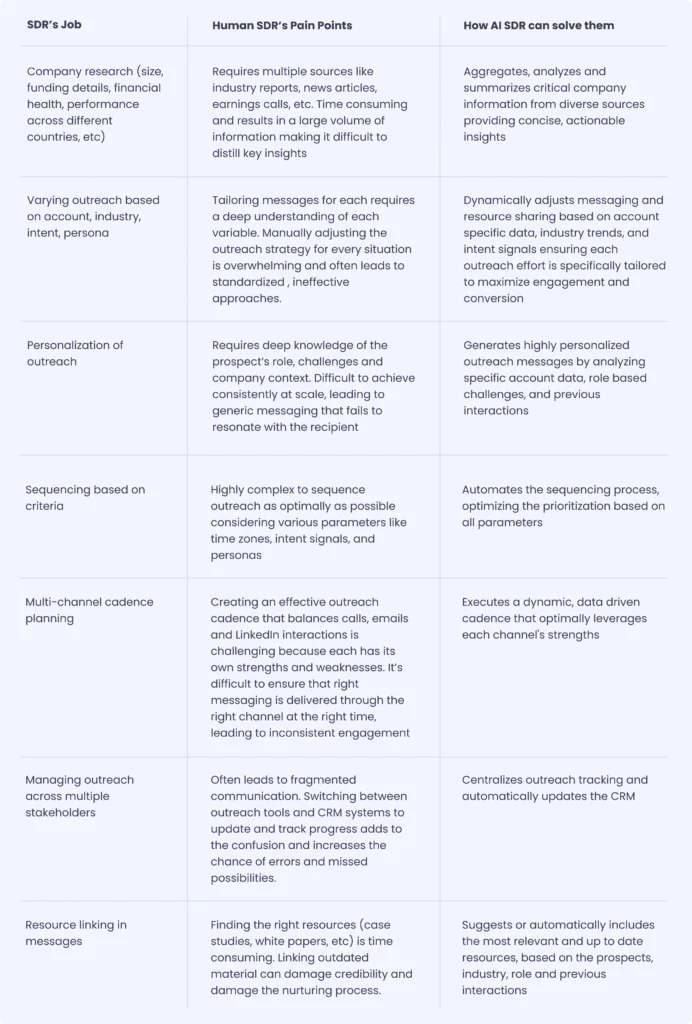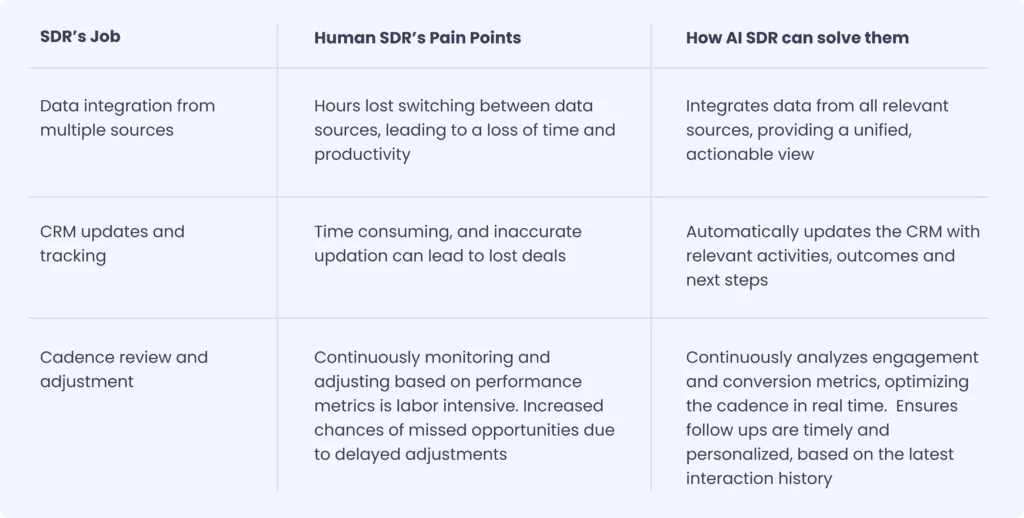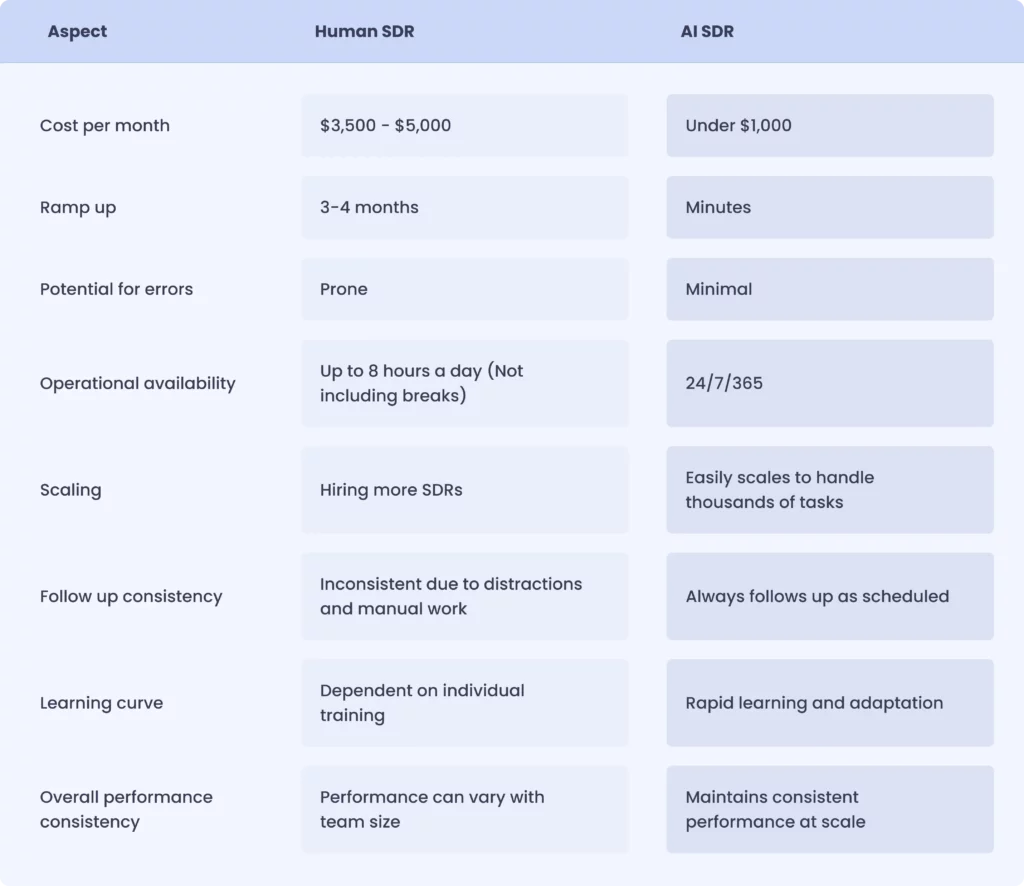1000-1500 SDR activities.
That’s what it takes to generate a single opportunity today.
Businesses value the SDR function, with SDR salaries in the U.S. averaging around $55k a year, and 50% of Chief Sales Officers identifying outbound prospecting as a key priority.
Yet, traditional SDRs spend only 30% of their time on actual selling, with the rest consumed by administrative tasks that leave high-value phone conversations, with a 40% conversion rate, underutilized.
This model is broken because it focuses too much on manual work and generic outreach, is misaligned with modern sales goals, and wastes valuable selling time.
The inability to utilize the best channels and the time wasted on non-calling administrative work prevent SDRs from engaging meaningfully with prospects.
Currently, SDRs spend all day on
- Research and list-building
- Email creation
- Follow up across multiple accounts, prospects, and weeks
- Managing their pipeline
- Data entry
just to secure one qualified conversation per day.
As we delve into these issues, it’s clear that the problems stem from a flawed tech stack, unrealistic expectations, and a relentless race to do more, which has led to an arms race of ineffective tactics and inbox overload.
Why Today’s Sales Tech Isn’t Helping SDRs Where It Counts
Despite sales tech evolving over the years, SDRs are still bogged down by the same old problems. Downtime is a big one- it eats into valuable calling hours, which in turn leads to missed quotas. More importantly, the current tools
- Don't gel well with the SDR role:
Forcing them to treat all accounts the same, handle tedious admin work, and deal with ineffective spam-like outreach. They also lack the flexibility needed to adapt to changing sales strategies and individual account needs.
- Create friction between buyers and sellers instead of aligning them
Today’s buyers are more diverse, demanding, and dynamic than ever. But human SDRs just can't keep up—it’s simply not possible to scale their personalized efforts consistently to match them. This disconnect results in poorly targeted communication and a lack of meaningful engagement, frustrating buyers and reducing the effectiveness of sales efforts.
Current sales tech adds to the challenges rather than solving them.
But.. What if there’s a way to eliminate the repetitive tasks, boost lead qualification accuracy, and ensure consistent follow-ups? What if you could improve your SDR conversion rates at a fraction of the cost and time and with higher conversion rates? What if you had an intelligent companion who works tirelessly, understands and improves the process, and adapts to new strategies—all in a snap?
Introducing AI SDRs
Recent innovations in GenAI and LLMs have significantly advanced their capabilities, allowing them to handle more complex interactions and provide deeper, more personalized insights. These advancements in GenAI include specialized models that can now chain together to deliver tailored responses and manage intricate tasks effectively. Which gives us AI SDRs, designed to automate repetitive tasks and free up human SDRs to focus on building relationships and closing deals.
One such AI SDR is sdrX by Klenty, which uses advanced GenAI models to automate follow-ups, personalize outreach, and track lead activity. This helps SDRs engage more with prospects and focus on high-impact activities.
In this blog, we’ll dive into how AI SDRs stack up against traditional human SDRs and why adding the AI SDR to your team is the breakthrough your sales strategy needs.
The AI SDR Shift: Old Vs New
Stage 1: Prospecting and Planning
For human SDRs, this stage often means painstakingly filtering through massive data sets, manually verifying contact details, and segmenting prospects—all while juggling time-consuming tasks. The big picture? Effective prospecting is crucial for building a strong sales pipeline, but the traditional approach can be slow and error-prone.

Stage 2: Execution and Engagement
The complexity of juggling detailed company research, multi-channel outreach, and personalized messaging often leads to wasted time, fragmented communication, and forgotten follow-ups. This results in missed opportunities and a reliance on generic messaging that doesn’t always hit the mark.

Stage 3: Optimization & Hygiene
This stage is essential for maintaining momentum and driving successful outcomes. But as you may suspect, it involves tedious tasks like reviewing and adjusting cadences, managing pipelines, and updating CRMs, all of which can be prone to error and loss of valuable time.

Putting It In Perspective

In Conclusion
If you’ve read this far, it’s safe to assume we’ve piqued your interest. The challenges of the current processes are clear. Missed follow-ups, generic messaging at scale, and lost sales opportunities are just the tip of the iceberg.
Imagine an intelligent companion that manages all outreach activities—from list-building to email conversations. That’s sdrX. It's not just your best SDR; it's better. sdrX gives you
- Timely follow-ups with automated scheduling
- Automated follow-up sequences for reliable communication
- Personalized messaging to connect better with leads, moving away from generic outreach
- Automated scoring to optimize lead management for more effective results
- Real-time alerts on lead activity to help capture every sales opportunity
- Detailed analytics and performance reports
- Automatic CRM data entry,
allowing your SDRs to focus on what’s most valuable, building relationships, and making impactful phone calls.
With sdrX, your team can save time and close more deals. Request early access to sdrX today because hitting your quotas isn’t easy, but it can be.


 Terms
Terms